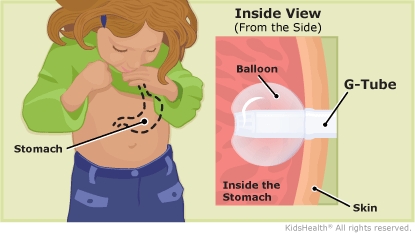Gastrostomy Tube (G-Tube) Placement: How to Care for Your Child
A gastrostomy tube (G-tube) puts food and medicines right into your child's stomach. A surgeon placed the tube, and you learned how to use it. Your child is now ready to go home. Follow these instructions to care for your child and the G-tube.


Pain:
G-tube care:
-
Put a snug layer of clothing over the tube to stop your child from pulling on it. For infants and toddlers, a one-piece outfit works well.
-
Always wash your hands before handling the G-tube or the area around it.
-
Clean the area around the G-tube every day, and whenever it looks dirty. Use warm water, soap, and a gauze pad. Rinse with warm water and dry the skin well with a clean towel.
-
Follow the instructions for how much and when to feed your child, as well as when to vent (release gas from) the G-tube.
-
Flush the tube with water after every feeding and after each dose of medicine.
-
Follow the care team's instructions for clearing any clogs from the tube.
-
Kids should have sponge baths until the health care provider says it's OK to take a bath or shower.
-
Always keep the feeding set tubing out of the way of infants and children. There is a risk that the feeding set tubing can get wrapped around a child’s neck, which could lead to strangulation or death.
Activities:
-
If your child does tummy time, the care team will tell you when it is OK to do this again.
-
Don't let kids swim or go in a pool until the care team says it's OK.
-
Find quiet activities that your child can enjoy until the care team gives the OK for normal play.
-
You can hold, talk to, and play with your child, especially during feedings.
-
Don't let your child lift anything heavier than 5 pounds.
Follow-up appointments:

-
Your child has fever.
-
Your child has belly pain.
-
Your child has a bloated or hard stomach.
-
Your child is throwing up or has diarrhea.
-
Your child has trouble passing gas or pooping.
-
Your child is coughing.
-
You can't clear a blockage in the tube.
-
The tube is leaking.
-
The tube sticks out more or less than it had been before.
-
Pink or red tissue, a rash, or bleeding develops around the tube.
-
The area around the tube becomes red, swollen, tender, or warm.
-
There is yellow, green, or smelly discharge around the tube.


How does a G-tube work? Some kids can't eat and drink enough to stay healthy. G-tubes put the liquid, calories, and medicine kids need right into their stomachs.
A water-filled balloon holds the G-tube inside the stomach. The plastic piece on the outside holds the tube snug against the skin.
How long does a G-tube stay in? Some kids need G-tubes for a short time. Others use them for years or for life.
G-tubes must be replaced every few months. When kids first get a G-tube, it takes a while for the skin to heal. So the first G-tube replacement must be done in the surgeon's office or hospital. After that, you will learn how to replace the tube at home.
How do I get the supplies I need? The hospital team will arrange for a medical supply company to send everything to your home. Make sure you get the contact information for the supply company so you can order extra equipment and formula if you need to.
Some supplies, like syringes and the extension tube, can be cleaned and reused. Follow the care team's instructions on how to clean and dry them.
Can kids with G-tubes still eat regular food? Some kids who can safely swallow might be able to eat food normally. The medical team will let you know if your child can eat or should be fed only through the tube.